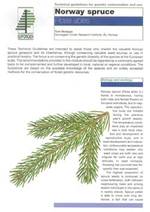Picea abies - Technical guidelines for genetic conservation and use for Norway spruce
This publication has been translated into the following languages:
French Slovenian Italian
Genetic conservation of P. abies is done by proper use of reforestation materials and by specific in situ and ex situ conservation activities. In reforestation, the minimum requirement should be that the origin of the reproductive material is known, and its adaptive properties should be appropriate for the ecological conditions at the regeneration site. A system for the control of reproductive materials should be established and recommendations for proper use of different materials should be developed. The OECD Scheme and EU regulations provide basic definitions of different categories of reproductive materials. The P. abies seed samples of recommended seed lots for practical reforestation should be harvested in years with abundant flowering and seed production and be stored in sufficient amounts in seed banks.
In situ conservation of P. abies is often successfully done in protected areas. In several countries, however, protected areas alone do not fulfil the actual needs and requirements for the conservation of genetic resources of forest trees. There may therefore be a need for gene reserve forests, established in natural stands and managed according to silvicultural practice, such as thinning and harvesting, ensuring the potential for successful regeneration. The objective is to maintain the potential for continuous future evolution of the population. It has been suggested that gene reserve forests should cover areas of at least 100 ha, but smaller areas can also serve the purpose. Such forests may consist of a mixture of different species, if that is their natural species composition. In areas where P. abies is not a native species, it may be desirable to conserve the genetic variation of well-adapted “landraces” in gene reserve forests.
Establishment of ex situ conservation plantations of P. abies may be necessary in order to conserve the genetic variability of threatened populations that cannot be maintained at the original site. The objective will be to establish a new population that maintains as much as possible of the original genetic variability and allows for long-term adaptation to the local conditions at the planting site. It can be established by planting of seedlings, but also by direct sowing or vegetative propagules. Sizes of 2–5 ha are generally recommended.
Specific genotypes of P. abies are conserved ex situ as vegetative propagules, in most cases as grafts, in clone banks or clonal archives. Several replicates should be made of each clone to reduce the risk of loss due to fire and other disasters. Clonal archives are static gene conservation units, with no natural regeneration intended in the plantation. They often contain members of breeding populations that are characterized genetically and are used to provide scions to be grafted in seed orchards or to make controlled crosses. All populations belonging to a breeding programme, such as seed orchards and progeny tests, are important gene conservation units as they contain materials with known genetic properties that can be used to generate new populations with known adaptive and wood-production characteristics. Breeding populations organized in a system of multiple populations at different sites have particular value for conserving genetic variability both within and between populations.
Field experiments with provenances, families and clones of P. abies have provided important genetic information for both breeding and conservation activities. Although such trials were not designed with gene conservation in mind, they are important reservoirs of characterized genetic variability and should be managed and maintained as long as possible and be considered part of a national conservation strategy.
Any type of forest reproductive material of P. abies (seeds, pollen, vegetative parts) can be conserved in genebanks. This will be a complementary method to the ex situ and in situ plantations, and will, apart from genetic changes due to loss of viability, conserve the original genetic structures.
Authors: Tore Skrøppa
Corporate Author: European Forest Genetic Resources Programme; International Plant Genetic Resources Instit., Rome (Italy)
Journal/Series: EUFORGEN Technical Guidelines for Genetic Conservation and Use
Publication Year: 2003
Publication Format: Folder; PDF
ISBN: 92-9043-569-0
ISBN 13: 978-92-9043-569-3
Language: EN
Pages: 6 p.

